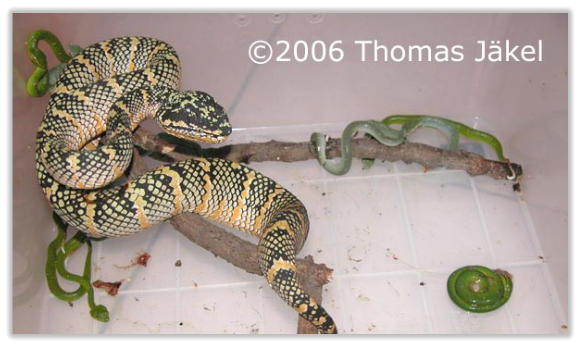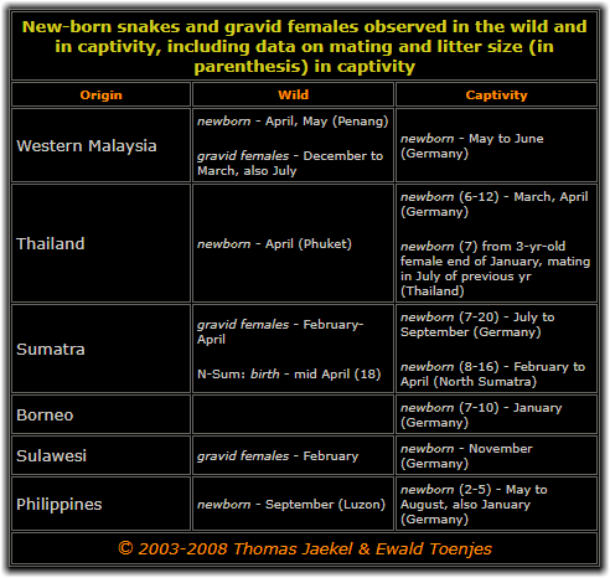


![Breeding Breeding of Wagler's Vipers in captivity is possible and not too difficult once the animals are healthy and stress (induced by cagemates or otherwise) is avoided. The image below depicts an adult Sumatran female copulating with an adult male. This behavior can be stimulated in captivity by simulating heavy rainfall during certain months of the year, for instance during October to December in the case of southern Thai or western Malaysian animals. Mating can occur at any time of the year if male and females are kept together in a container. However, keeping several snakes permanently together can only be recommended in a large container, providing enough resting and hiding places for each individual snake. These vipers are solitary animals. Especially females do not tolerate each other very well, and they do not tolerate males during certain periods. This may be become obvious by an inferior animal losing appetite in presence of a superior, but can also result in open aggression involving bites. If cages are small (e.g. 60x90x40, LxHxD[cm]), males are kept solitary and separate from females for most of the time. In case of Thai and western Malaysian animals, August to February is suitable period to try breeding. A male that has been kept solitary for a while usually mounts a female immediately once placed into a container together with her. It starts to make jerky movements and tries to get a grip of the female's tail in order to position its cloaca close to hers (see photo above). The copula may last many hours, and can be repeated various times in the weeks to follow. Females are usually quite lethargic and tolerate all of the male's attempts. Should there be signs, however, that the female rejects the male, the latter should be removed immediately. Here are some climate charts (temperature and rainfall) of various locations in Southeast Asia that could be helpful for designing the right climatic conditions in a container throughout the year (move over the image to zoom in). The length of the gestation period is difficult to determine exactly, because not every copulation will result in fertilization. Furthermore, a single insemination by a male viper may be sufficient to induce offspring for two consecutive years. We have observed this especially with females from the Philippines. Usually the gestation period of Thai, Western Malaysian and Bornean females lasts 6 to 8 months. The table below summarizes our experiences with breeding of temple pit vipers in captivity as well as some of our observations in the wild. If one assumes a 6-months gestation period, and compares the data in the table with the corresponding climate charts above, it is probable that mating in Thai and western Malaysian populations occurs around October to November, during the rainy season. However, I also observed gravid females on Penang island in July, meaning that mating in the wild may take place also during other periods of the year. Northern Philippine populations (Luzon) may mate during the dry season, provided that the Manila chart is some kind of representative for other locations in the northern Philippines. Gravid females usually give birth during the night. The tiny newborn vipers (around 20 cm) are quite agile and can climb vertically sticking to the wall of the container after spraying with water. Young Wagleris look very similar, regardless of their geographic origin. I have developed some kind of sense to distinguish them, however, coloration can be misleading. The juveniles displayed in the 'Biology' section are typical for populations in Thailand and western Malaysia. Sumatran newborn tend to show a stronger uniform green, with a green or yellow venter and strongly contrasting red-white marks on the back. However, blue forms also exist (See the blue and green newborns from Narathiwat province of Southern Thailand below). Usually, all of them are quite docile and do not readily accept baby-mice. Philippine newborns have a fairly different temper. They are similar in size like young of the other populations, although the parents are relatively smaller (females, 60-90 g, 40-50 cm; males around 30 g, 40-45 cm) than their Sumatran or Malaysian counterparts. They are quite agressive and immediately accept newborn mice, dead or alive. This holds true also for young of some populations from Borneo.](index_htm_files/10468.png)
© 2004-2022 Thomas Jäkel
Newborn vipers that do not accept newborn mice either have to undergo assisted feeding (see page
'Wagler's viper in captivity') or offered small lizards, especially geckos. As geckos are usually not
readily available, assisted feeding is the only choice. Even if lizards were available, one has to
consider that once the snakes get used to this prey item, it might be difficult to change the diet later.
So, better start with mice right from the beginning. A leg or tail of a newborn mouse given every 2
weeks is sufficient at the beginning. At a later state, attempts should be made in stimulating the
young vipers to take a complete newborn mouse. This can be best achieved by heating a food item
under a lamp (about 40° C) and moving it in front of the young. Touching its back or tail also
provokes bites, and finally takes.
Once juveniles accept newborn
mice or parts of it, things are going
to be easy. Then, it is very
important not to overfeed the
young. This means practically, a
next feeding session is scheduled
only, after the animal has
completely defecated (urid acid
and fecal pellet).
Wagler’s Viper Site - Husbandry










© 2004-2021 Thomas Jäkel

Breeding
Breeding of Wagler's Vipers in captivity is possible and not too difficult once the animals are healthy and stress (induced by cagemates or otherwise) is avoided. The image below depicts an adult Sumatran female copulating with an adult male. This behavior can be stimulated in captivity by simulating heavy rainfall during certain months of the year, for instance during October to December in the case of southern Thai or western Malaysian animals. Mating can occur at any time of the year if male and females are kept together in a container. However, keeping several snakes permanently together can only be recommended in a large container, providing enough resting and hiding places for each individual snake. These vipers are solitary animals. Especially females do not tolerate each other very well, and they do not tolerate males during certain periods. This may be become obvious by an inferior animal losing appetite in presence of a superior, but can also result in open aggression involving bites. If cages are small (e.g. 60x90x40, LxHxD[cm]), males are kept solitary and separate from females for most of the time. In case of Thai and western Malaysian animals, August to February is suitable period to try breeding. A male that has been kept solitary for a while usually mounts a female immediately once placed into a container together with her. It starts to make jerky movements and tries to get a grip of the female's tail in order to position its cloaca close to hers (see photo above). The copula may last many hours, and can be repeated various times in the weeks to follow. Females are usually quite lethargic and tolerate all of the male's attempts. Should there be signs, however, that the female rejects the male, the latter should be removed immediately. Here are some climate charts (temperature and rainfall) of various locations in Southeast Asia that could be helpful for designing the right climatic conditions in a container throughout the year (move over the image to zoom in). The length of the gestation period is difficult to determine exactly, because not every copulation will result in fertilization. Furthermore, a single insemination by a male viper may be sufficient to induce offspring for two consecutive years. We have observed this especially with females from the Philippines. Usually the gestation period of Thai, Western Malaysian and Bornean females lasts 6 to 8 months. The table below summarizes our experiences with breeding of temple pit vipers in captivity as well as some of our observations in the wild. If one assumes a 6-months gestation period, and compares the data in the table with the corresponding climate charts above, it is probable that mating in Thai and western Malaysian populations occurs around October to November, during the rainy season. However, I also observed gravid females on Penang island in July, meaning that mating in the wild may take place also during other periods of the year. Northern Philippine populations (Luzon) may mate during the dry season, provided that the Manila chart is some kind of representative for other locations in the northern Philippines. Gravid females usually give birth during the night. The tiny newborn vipers (around 20 cm) are quite agile and can climb vertically sticking to the wall of the container after spraying with water. Young Wagleris look very similar, regardless of their geographic origin. I have developed some kind of sense to distinguish them, however, coloration can be misleading. The juveniles displayed in the 'Biology' section are typical for populations in Thailand and western Malaysia. Sumatran newborn tend to show a stronger uniform green, with a green or yellow venter and strongly contrasting red-white marks on the back. However, blue forms also exist (See the blue and green newborns from Narathiwat province of Southern Thailand below). Usually, all of them are quite docile and do not readily accept baby-mice. Philippine newborns have a fairly different temper. They are similar in size like young of the other populations, although the parents are relatively smaller (females, 60-90 g, 40-50 cm; males around 30 g, 40-45 cm) than their Sumatran or Malaysian counterparts. They are quite agressive and immediately accept newborn mice, dead or alive. This holds true also for young of some populations from Borneo.



- Home
- Wagler's Viper Site (WVS)
- General Husbandry - WVS
- Breeding - WVS
- Health Problems - WVS
- Taxonomy and Phylogenetics - WVS
- Biology - WVS
- Geographic Variability - WVS
- How Females Change - WVS
- Venom - WVS
- Image Map - WVS
- Special: T. laticinctus - WVS
- Special: North Sumatra - WVS
- Special: Video on Mating - WVS
- Special: North Sulawesi - VVS
- Biological Rodent Control - BRC
- Rodent Management Laos - BRC
- Gallery
- Contact









